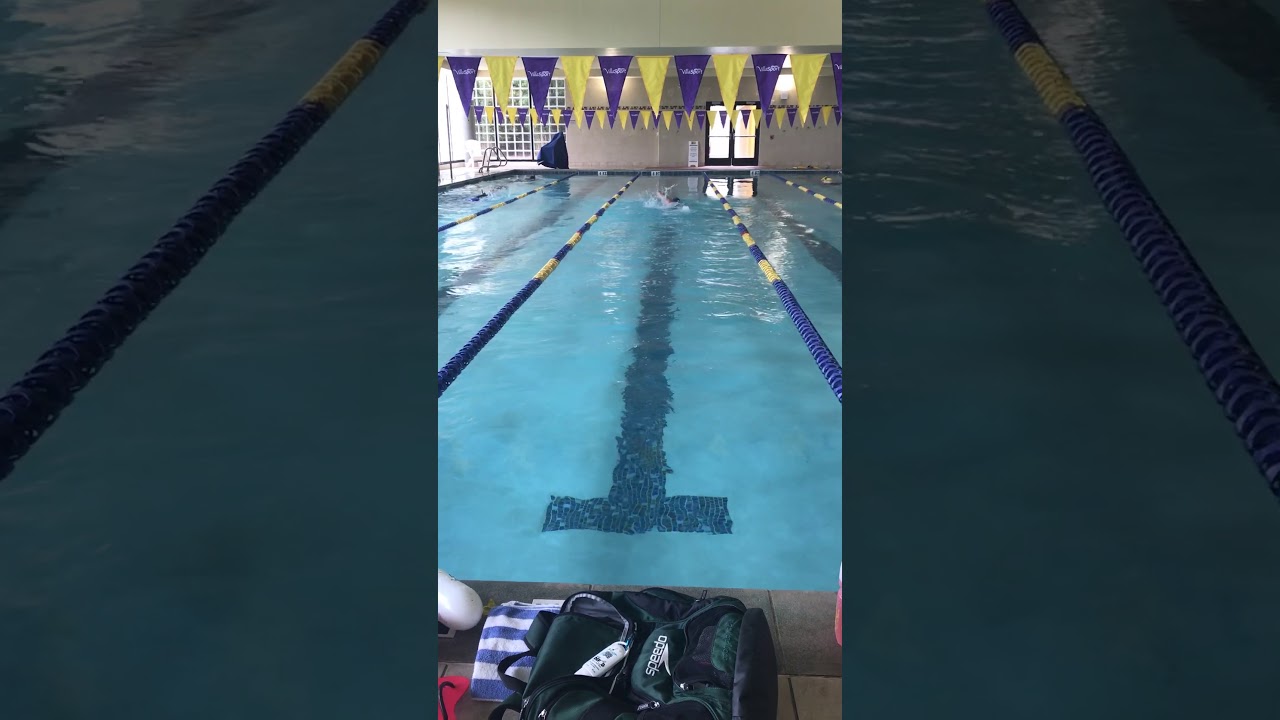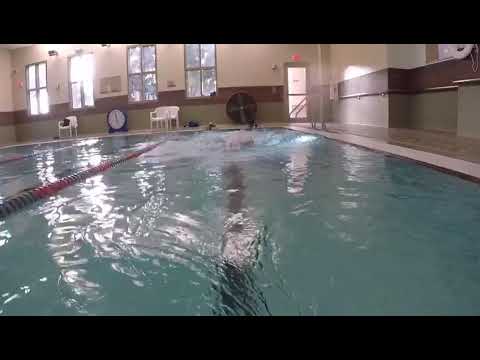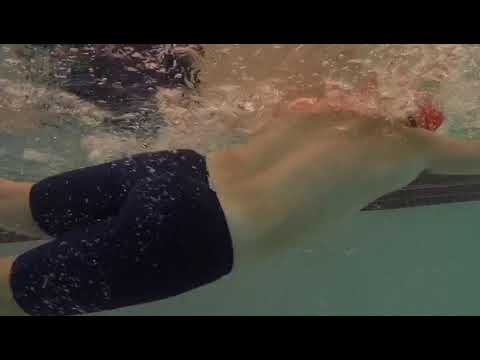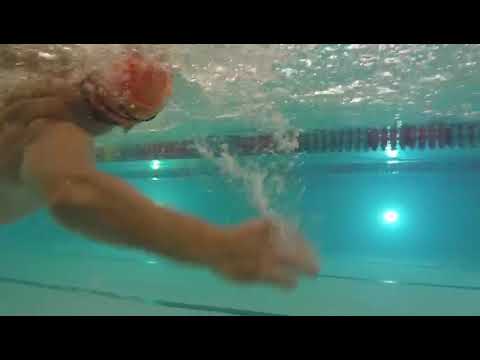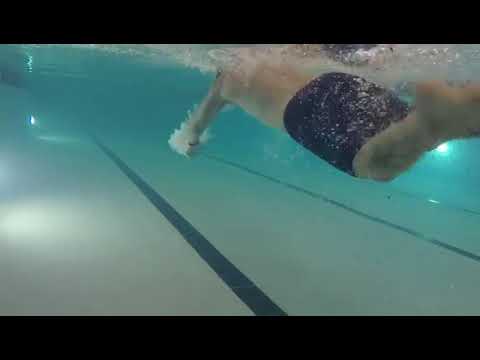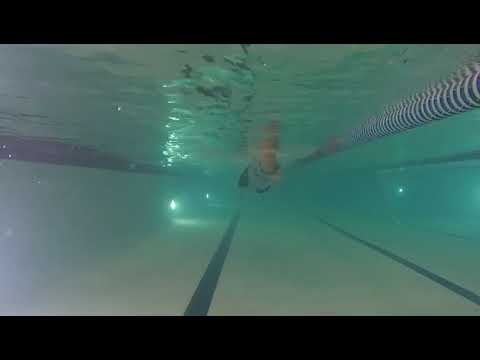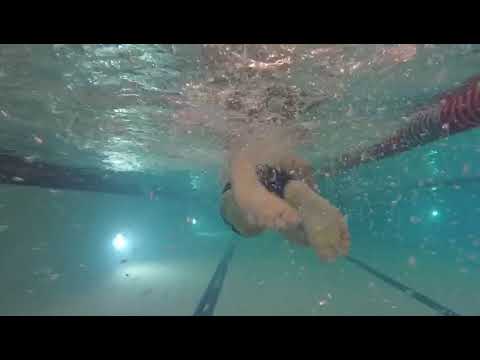Ok. I’ll start.
Here is my video from today. I set my tempo trainer to 73 beats per second which is about 85% effort for me. I normally do 1:26/100yd at that effort but somehow with the camera on, I saved 4s for a 1:22. Funny how that works. I don’t have an underwater shot. There was an old dude sitting there and I gave him my phone to video.
Lay it on me. I have a thick skin.
Definetely punching the water as befits the triathlete!
Disclaimer first, I am not a very good swimmer, we’re roughly the same pace (currently I am much slower after 4 months not swimming). Here are a few things that have been pointed out to me in the past and that I think I recognize in your footage as well.
- It appears that you hand enters the water very close to your center line, maybe even crossing it (more pronounced on left arm). You could try and reach further out and see how that feels.
- It appears that on breath you rotate slightly upwards, not strictly around your center line.
These two seem to introduce some wiggle in your stroke. I can’t see it really on the footage but I’d not be surprised if your kick had a higher than ideal amplitude, even the occasional scissor kick.
Generally though, at 1:22 you’re obviously doing something right. Spend a day or two learning to flip and you’re at 1:20 ![]()
Agreed w/ TG re: your left hand coming close to the center line, and possibly even crossing over. Also, your left arm is very flat in the recovery in comparison to your right arm, so your left hand is entering the water flatter than your right. You can probably improve your catch if you steepen your angle of entry.
Disclaimer - I am a crap swimmer and you are definitely faster than me, so feel free to disregard!! ![]()
Thanks @TG333 and @Power13. I’m on way for another swim. I’ll focus on my L hand entry today since it seems like an issue.
Oh man.
My swimmer friend was just in my office.
He filmed me last Friday, but we have only chat through wassap.
He showed up today and actually show me what he was explaining on the chat.
Oh boy.
Ive been swimming so wrong the last 3 years. Like horrible wrong. No wonder why im not moving forward.
He explain in detail how i should be doing the pull to maximize power… and is not even close to what i was trying to do…
Looking forward to try tomorrow
Work on one thing at a time. The brain can’t handle too many changes at once.
Okay, I also see the hand close to centre line but I dont see them crossover and I dont think thats a fault to fix. In open water you might want to be a little wider as apparently thats more effective in OW.
Cant see whats going on closer but I would be wondering if the low left, high right recovery might indicate that the roll is too flat on one side, too exagerrated on the other. But this might be a more effective technique in OW.
You swim better than me.
The two things I noticed were
-
You only breathe on your right side. Is that always the case? If so, I would practice breathing on both sides. Even if you never race like that it can balance out your stroke and then if you swim OW you have the ability to sight better to both sides or if someone is splashing on your right you can breathe to the cleaner side.
-
Many times people will have a much straighter and higher recovery on one side to try to get their arm out of the way of their face when breathing to compensate for not rotating enough. If you look at your hips you don’t ever truly get on your side. Ironically, the drill progression we used was called Sweet Spot. It’s basically balancing on your side and then slowly introducing a catch, pull, and rotate.
Great point…Being able to breathe from both sides is definitely a useful skill and should be practiced. For many triathletes, especially in races, they should breathe every stroke however. So bilateral breathing (breathe right, then breathe left) is not the most efficient option as you are depriving yourself of oxygen longer than you need to. Fro swimmers, the events are short enough that you can do it since speed is emphasized over endurance.
So to work on breathing both sides, simply change which side you breathe from every length, lap or repeat. Breathe to the left on one length and then to the right coming back, etc.
It’s definitely not symmetrical. The roll on the left and the arm recovery with the left is definitely not the same as the right. I’ve had someone tell me this before. Under water I feel like I am rotating on the left because my R ear is touching my shoulder and I open up to allow the L arm to push back with my forearm and hand pointing down. But every time I video, it’s not symmetrical. Maybe there is extra rotation on the right for breathing.
I’ll have look that drill up!
Regarding breathing, I used to be a 3stroke breather until I did T26 and they told me to do 2strokes. Their rationale is that you get more oxygen and go faster. I can breathe on my left and have used it when the sun has been on my right but I prefer the right. I may try breathIng on the L Only on my returns like Power13 says. Never thought of it as balancing thing.
Yes…
I am approaching this as I am relearning how to swim.
So for now im doing lots of drills (25/25) and focusing on the pull and some 25s at the end.
Did it this morning I felt great. I was doing 25 on the usual speed (25s). But fewer stokes per length and i was not winded at the end.
Also did a run after the swim (a wo of 18x30 on /30 off) and felt much better than last week.
Maybe is placebo IDK.
I will continue focusing on my pull for the next 3 weeks (3x per week) hoping to improve.
It’s an excellent drill progression. I swam year round from 4th grade through high school and we did it almost every practice the entire time. It gets you comfortable balancing totally on your side which is where you should be spending almost all of your time while swimming freestyle.
This is what I did. Right side going down, left side coming back.
But ultimately I think the biggest thing is to get comfortable moving your hips from side to side. Most of your power comes from your core and you can’t generate that power if your hips stay flat in the water.
Where to upload video?
YouTube?
Hi! I have been a swimmer for forever and a half (age 8 through college, sadly on pause now due to COVID!). Also did some coaching. Agreed with the points above about symmetry, breathing every 3rd, and getting on your side with each stroke.
two things to add:
1: Make sure your hips are up, and staying up. This involves impeccable body position and core strength. You seem to be moving with effort through the water; it should look effortless, especially at that pace.
One drill to try is a body position drill where you kick face down, hands by your side, and slightly press down at the “T” of your chest/shoulders every 10 kicks. When you swim, you should incorporate this slight downward pressure of the “T” to keep hips up.
2: someone above mentioned a Sweet Spot of positioning on your side. I had a coach that described this as being on railroad tracks: you rotate to line your right side up on one side of the tracks, then rotate to the left side. Also, you are almost always rotating less than you think you are, so keep on taking videos!
Sorry for the novel, message me if you have more questions! Could talk about swim technique for days ![]()
Emily
@Alen, good on you filming and putting out there.
On the breathing, I would rethink the advice. The every-two stroke breathing will get you more oxygen but at your endurance intensity, do you need it? I would shift back to three-strokes, which apparently you did, for the benefit of bilateral viewing and possibly balancing your stroke (more below). Or, if that’s difficult, as it is for me, to four-stroke breathing with “down-shifting” (or is up-shifting?) to every other stroke as intensity and oxygen demand requires. You can get comfortable doing endurance sets, faster-than-normal swimming with four-stroke breathing. It’ll take practice but you’ll build up the capacity (which will benefit the other disciplines, from personal experience). I know/knew Gerry of T26 (he was at my wedding, I swam under him, and I coached for him when he was the UCLA Masters swim coach back before and after the turn of the century) and I think the every-two breath was contingent and not universal.
On the arm entry and recovery, as was mentioned, it’s not even. I didn’t see a centerline issue, but there is an issue I saw with your catch and pull, which I’ll get to. As @Joex wrote, generally a slightly wider (ie not centerline) entry, say shoulder width, will be better for open water swimming. Most of the time, open water swimming will have some element of chop. Ocean swimmings are more likely, as a result, to have a choppier, more aggressive stroke, perhaps looking more like a water polo stroke at times. (Only slightly off-topic: I found water polo to be the best prep for mass swim starts. From protecting the face to getting through the crowd… I digress). However, I do not think you should focus on that now, which I think is a safe and fair implication from @emilys’s reply.
Your body rotation is the first place to start, in my opinion, as @emilys describes. Rotating the body more allows you to stretch out the reach for a good catch and a pull that will involve more of your back. When you start focusing on this reach, I think you’ll notice after your first workout that your back muscles (delts, lats, dorsal) are really sore. That will reveal that you’ve not been engaging them enough. Your core muscles are also drawn into the stroke more. Freestyle is more about the back than the biceps. Practice the exaggerated rotation with a long reach and focus on doing the same, ie not just as a drill, in every length. Eventually, the rotation will be natural and comfortable.
On the hips, focus on pushing the chest into the water. Secondly, focus on what used to be called “front quadrant” swimming. That is, you don’t start your pull until the opposite hand is at your ear during the recovery. Also, make sure you are looking straight down. Lifting your head up to see ahead under the water will push your hips down. If you need to see ahead, like when looking for the T, look through the top of your goggles (ie up with your eyes, not your head). Also, you may want to incorporate a heads up look at the wall every now and then to make that a comfortable part of your stroke for when you need to navigate. In a 50m pool, I tend to do that every length just because. In a 25m community pool, I will often do that every length as practice with the double advantage of seeing if anyone is about to get into my lane.
Back to the breathing and incorporating the above, you may want to buy a centerline snorkel. This will allow you to breathe without rotating your head. By removing the rotation to breathe, whether every 2 or 3 or 4 strokes, you’ll be able to focus on your form in the water. Also, make sure you do breathe 90 degrees to the side, not forward. Your head swivels, not angles, to get air. Another advantage of breathing every third or fourth stroke is you have time to fully exhale before you inhale. 3 or 4 stroke breathing will be easier as you work on it and build the necessary endurance.
On the paddles, which I can just see in the video, remove the lower hand strap. The lower hand strap allows a lazy or improper form. Drop that strap and a poorly “aimed” pull (ie not straight) will cause the paddle to slip off. Your hand should be relaxed and not tense trying to control the paddle. These are my paddles, as an example. I would not get the funky-formed / shaped / molded paddles as they too may mask poor hand angle and position during the important pull phase.
On your arm recovery, you’re lopsided. Your left is much lower than your right. It looks less like an artifact of breathing and more like a flexibility, or even strength, issue. I wouldn’t be too concerned about the lopsidedness at this point. There are other things to focus on that may address that. (I’ve been told by many people that my stroke is lopsided to the point they can pick me out not just in the pool but in mass starts. I was a 52min IM swimming but now a 59min swimmer, but then I swam with a club – Gerry’s, as a matter of fact, before he started T26 – x3 a week plus a fourth time of 2-3mile ocean swims and now I swim alone and only x2-3 a week in a pool, when I’m swimming that is, and am ±18yrs older than then.)
I agree with @TG333: practice your flip turns (or “tumble turns”). It’ll increase the efficiency of your swim workout. On the push-off, keep your head down, tucked between and effectively below your arms, kick, and take a stroke before your first breath.
Lastly, practice the other strokes. The backstroke is an obvious complement to front crawl. It’ll work similar muscles in a different way. It’ll help make you a better swimmer. Through in some fly and breast to build strength. If just starting fly, do one-arm fly, throw in a two-arm fly every third stroke, etc. It takes time to build up, but it’ll benefit your overall swim (and general) strength. It’ll make you a better swimmer.
I hope that helps.
here we go…
Please be gentle…
I know it looks bad…but i promise im working on it…
this was taken on June 26.
please ignore the swim cap… I know it was lose… ![]()
![]()
Thanks Emily.
Actually that drill with the chest helped me a lot a few years ago and I have been telling my friends to do it all the time.
Please stick around and comment on other people’s videos.
I don’t know how to make it look effortless! Would love to do it. I see an occasional great swimmer come to the pool and I know what you’re talking about but making it look effortless is a tall order.
That’s a lot of good advice and I appreciate the time you put into it.
I will make the adjustments you mentioned. I have a center snorkel and use it often just for what you said. But I have more work to do it seems.
Regarding the flip, I am able to do at the cost of dizziness and a big headache for the rest of the day. So I just give up the couple seconds and focus on the stroke.
